Home » Construction Blogs (Page 7)
Category Archives: Construction Blogs
Deere: Split With Hitachi Allows It to Flex Technology Muscle
What was behind the surprising Deere-Hitachi excavator split announced in August? What will this mean for Deere customers of both brands?
P
RuccoloJohn Deereerhaps a better question is what it won’t mean, says Domenic Ruccolo, speaking to Equipment World about the split. Ruccolo, a Deere veteran, is the company’s new senior vice president of sales, marketing and product support, global construction equipment. He also serves as chief sales officer for the Wirtgen Group.
“From a customer-support standpoint, I think the best way to put it is that there will be no change,” Ruccolo says. Irrespective of brand, Deere dealers will continue to support everything they have sold over the years “indefinitely,” he says.
“There’s no question that we had a very successful partnership with Hitachi throughout the Americas for more than 30 years,” Ruccolo says. But times have changed, and “it was the right time for both of us to make this change,” he says. “Where we are really going our separate ways is on the marketing and product support side.”
After Feb. 28th, Hitachi Construction Machinery Americas will take over distribution and sale of its excavators. Hitachi plans to manufacture all of its excavators in Japan and import them to the North and South American markets. All manufacturing plants in the joint venture will remain with Deere post-split. This includes its flagship manufacturing facility in Kernersville, North Carolina, as well as plants in Brazil and British Columbia.
That doesn’t mean all has ended between the two companies, however. “We’re going to continue to have a strong relationship with Hitachi for years to come through our continuing supply agreement with them,” Ruccolo says.
Hitachi plants in Japan, for instance, will still make its above 47-metric-ton models, the 670G and 870G, and its 190G wheeled excavator.
Technology centric
During the joint venture, Deere relied on Hitachi’s excavator technology, although Ruccolo points out that Deere has developed its own excavator models over the past 13 years that were sold in markets such as Australia, Southeast Asia and Russia. “The agreement gives us the flexibility to transition on a model-by-model basis to Deere technology,” Ruccolo says. “We’re really excited about the opportunity to control our own journey in excavators.”
Ruccolo also says this transition to Deere technology supports the company’s overall smart industrial strategy announced in 2020.
“Obviously when we have our own technology in excavators, it makes the deployment of them a lot easier for us,” he says. Deere can also apply technologies to excavators that it develops in other markets — notably agriculture and as the result of acquisitions such as autonomous driving start-up Bear Flag Robotics.
Dealer reaction
Ruccolo says the Hitachi split was not expected by dealers, “and there was a bit of a shock factor.”
Still, “there’s a lot of excitement and a lot of energy around what the future holds” on the dealer side, he says. “Once we had the opportunity to explain the transition and what the future holds I think generally dealers are quite excited about the future.”
He also says that by now Deere dealers are already well-versed in Deere’s new smart investment strategy. “Customers are going to experience the same continuity and exceptional support that comes in the form of reliable access to parts, solutions and service,” he says.
Three years down the road?
If plans proceed as envisioned, three years from now contractors will look back on an uninterrupted customer experience, Ruccolo says. “We intend to be there every step of the way from a support standpoint for our customers and dealers,” he comments.
And will the Kernersville plant start to produce excavators beyond its current 13- to 47-metric-ton segment? Ruccolo declined to comment.
The Deere-designed and manufactured excavator line, however, will be in full transition. “We want to accelerate the development of what we feel is industry-leading technology and machinery,” he says. “We’re full steam ahead.”
Did you miss our previous article…
https://constructionosa.org/?p=381
Ways to Boost Productivity in Your Construction Business

The efficiency of a construction site depends on the productivity of the workforce, sufficient planning, and proper site management. Meeting the demands of the growing construction industry calls for innovative solutions to improve productivity.
Overview
The construction industry continues to flourish as a growing population and urbanization fuels the demand for infrastructure, residential and non-residential properties. Despite representing 13% of the global GDP (gross domestic product), the sector experiences slow productivity growth. Over the past two decades, productivity has grown at an annual rate of one percent. Due to the low productivity, the sector experiences project delays that lead to budgeting complexities and the disruption of workflows.
Some of the productivity challenges in the construction industry are:
* Slow implementation of technology and automation tools
* Poor communication and coordination among the workforce
* Inefficient utilization of time
* Skilled labor shortage
For the sector to enhance its efficiency, it is crucial for stakeholders to seek solutions that address technological, workforce, and fleet management gaps. Apart from streamlining operations, these solutions guarantee a smooth transition towards sustainability in the construction sector.
In general, workforce productivity in the construction sector estimates the physical progress per unit per person-hour or any other metrics adopted by a company. For companies to sufficiently quantify productivity, they have to measure:
* The level of effectiveness of the labor — What is the total cost for constructing a unit area?
* Relative efficiency of the workforce — Is the workforce performing the right tasks at the right time?
Improving the productivity of the construction workforce comes with radical changes in sector regulations, research and design practices, workforce management, and on-site management strategies. Construction companies can boost their productivity by incorporating the following ideas into their business operations.
1. Implement digital technology
The project design phase consumes a considerable amount of time. Most businesses create standard design libraries for repeatable construction elements to reduce project design time. Through digital tools such as BIM (building information modeling), companies can create multiple designs, develop digital prototypes, and analyze the sustainability of new construction materials before physical implementation.
Using the 5-D BIM technology grants an organization the ability to transition into complex projects like underwater civil projects which adopt non-conventional parameter specifications.
At construction sites, supervisors work with extensive teams. They assign work and dispatch employees to the appropriate working locations depending on their skills and availability. While performing their duties, the company has to update the attendance of the workforce in real-time, keep a log of construction activities, and reconcile payrolls to match timesheets.
Relying on manual tools to perform these tasks is tedious and can impede the transparency of operations. Through technology, companies can improve workforce management by providing automated tools for multi-location scheduling and timesheet management. It creates transparency and allows the company to track productivity in real-time, facilitates accurate dispensation of information, and enhances labor planning to avert employee shortages.
Reducing construction waste, site safety incidents, and supply chain inconsistencies remains a challenge in the construction sector, leading to project delays. Companies are undertaking rigorous research and development to optimize operations and minimize risk, which causes costly delays. Technologies like digital twins enable companies to optimize their designs, while analytics software provides them with insights on how to streamline supply chains. In the process, the company minimizes project execution costs and effectively utilizes the workforce.
2. Continuously train your workforce
Although the construction sector is enjoying steady growth, it is facing a shortage of skilled workers. As a result, companies have to find anyone interested in the construction work and expose them to on-the-job training. For business owners, they have to offer reasonable financial compensation to their skilled workforce. Apart from prioritizing cost-effective operations, companies have to maintain a stable workforce.
Companies that establish apprenticeship programs can attract a younger talent pool. Such programs ensure that the skills of the workforce meet the prevailing business needs. The apprentices learn the ropes of a trade by engaging in different construction tasks, equipping them with all-around skills. In due course, the team of apprentices fills in the vacant positions or replaces the aging workforce, ensuring the continuity of business operations.
As technological solutions make their way into the construction sector, there is a need for business owners to equip their staff with basic IT knowledge. The company hosts these solutions through cloud technologies and distributes them to the workforce through mobile devices or computers. Through training, the company describes how to fill in attendance records, record daily tasks, request materials/tools, and communicate with other team members through mobile applications.
Training is essential for enforcing a safety culture and enables the company to communicate any changes in safety standards. By training the workforce on safety and how to use advanced technological tools, companies enhance productivity by:
* Minimizing safety incidents
* Ensuring the workforce performs the correct work at the right time
* Providing timely access to critical information on mobile devices on project changes
3. Streamline on-site implementation
Streamlining on-site implementation involves a raft of lean operational measures that:
* Limit redundant activities
* Eliminate downtime
* Maximize construction materials — Keep construction waste at manageable levels
* Increase the utilization of construction equipment — Availability and timely maintenance of equipment
* Prevent unnecessary downtime — Non-designated break from work
To successfully streamline site operations, companies need to combine technology and encourage a progressive mindset among the workforce. They have to understand the importance of completing tasks within the desired timelines. The company should establish and enforce safety and construction standards, monitor the discipline of the workforce, and retain efficient workflows.
By assigning KPIs (key performance indicators), business owners can evaluate the project progress and organize rewards or incentives for teams that complete milestones in time. It motivates the workforce and encourages them to meet project goals.
Planning plays a crucial role in the success of any project. Before beginning the project, the company needs to create a PID (project initiation document) which lays down all the project requirements, project costs, and implementation timelines. It enables the company to plan for the workforce, formulate project goals, and create site-specific productivity measurement metrics.
The company needs to create a solid plan for logistics and supply chains. It minimizes interruptions to construction schedules and averts resource misallocation or misappropriation. With proper planning, every team member becomes aware of the project’s workflow process and productivity enhancement measures.
4. Keep communication clear
Solving productivity problems requires proper communication between the different levels of the workforce. Every team member, beginning from the architects to the on-site construction employee has to read from the same page at every project stage. Senior-level management must be aware of any on-site constraints and challenges affecting site construction workers. On the other hand, the implementation teams require timely updates on policy changes and project variations.
Slight communication breakdowns can result in project variations which is a leading cause for rework. When companies establish clear communication channels like Fieldwire, it is easier for employees from different professions to coordinate. Through mutual coordination, they can identify process bottlenecks and brainstorm ideas to eliminate them. With the evolving technology, the company distributes newsletters, reviews, and informational articles through mobile-based applications.
When companies communicate the importance of productivity to their employees and how it impacts daily schedules, the workforce develops a workplace culture that fosters teamwork, respect for each other, and adherence to site protocols. Communication channels serve as avenues for supervisors to conduct remote check-ins and verify whether the employees are at their designated places of work. It simplifies employee management and improves employee morale.
Summing Up
As the construction industry adjusts to market dynamics, business owners need to work towards improving the productivity of their workforce. Companies need to update their operating standards, match the skills demands of the employees, and adopt technological solutions as much as possible. Investing in the relevant technology guarantees workforce visibility and supplements project management strategies to steer businesses towards better profitability.
To understand how Fieldwire can help you and your team manage people and projects more efficiently, please register for a live demo of our platform below.
Schedule Demo
Derek spearheads key initiatives at Deputy, a global workforce management platform for employee scheduling, timesheets and communication. With a focus on construction and healthcare, Derek helps business owners and workforce leaders simplify employment law compliance, keep labor cost in line and build award-winning workplaces. Derek has over 16 years’ experience in delivering data-driven sales and marketing strategies to SaaS companies like MarketSource and Griswold Home Care.
Did you miss our previous article…
https://constructionosa.org/?p=375
Used Truck Prices Skyrocket, But Will the Bubble Burst?

The Class 8 auction market heats up more each month, and retail selling prices continue to crush records as the industry stands at the confluence of a strong freight market, an inadequate supply of low- to average-mileage used trucks and a shortage of drivers.
J.D. Power Senior Analyst and Product Manager of Commercial Vehicles Chris Visser, a guest during FTR’s ongoing virtual State of Equipment series, says “superheated rates” are keeping truck buyers energized. FTR forecasts rate increases to gradually relax and reach year-over-year parity starting in early 2022, while volume continues to grow into 2023. “In this market, we’re never going to have enough drivers to move the amount of freight that we have,” he says. “We’re really in a severe shortage of new trucks.”
The four-year truck trade cycle has been alive and well, Visser said, adding that 489,100 orders for trucks have been placed in the last 12 months with a bump in August due to the opening of model year 2023 build slots. However, OEMs have tamped down some of the enthusiasm as uncertainty surrounds the number of trucks they can build due to shortages of various components and workforce challenges.
Based on the number of trucks bought in model years prior, the supply of trades was naturally set to increase by roughly 20% in 2022, but Visser says the new-truck shortage will delay that increase.
Model years 2015 and 2016 are the most common trucks on the auction market, Visser notes, adding that if you can find three- or four-year-old trucks at auction, be ready to pay upwards of $100,000 for them.
“2019s are three years old, and those trucks are selling for well over $100,000 on the retail market,” Visser says, “and they’re being snapped up.”
Year-over-year auction pricing has increased more quickly and steeply than retail, as a lack of inventory is currently limiting sales.
“Dealers would sell more trucks if they had more trucks to sell,” Visser says.
An increasing number of fleets are bypassing dealers and auctions to dispose of late-model trucks because they’re so easy to sell. Visser adds the overall truck shortage has also pushed more fleets to the auction market as buyers, pitting them head-to-head against dealers and wholesalers on the auction floor and further driving up prices.
“When there’s no bargain price equipment that’s unwanted, (trucking) business is tough,” Visser says. “It’s getting more and more difficult for an owner-operator to purchase a used truck.”
Trucks 4 to 6 years old brought 86.5% more money at auction from January to July this year compared to the same period in 2020. Monthly appreciation has averaged roughly 4.8% in 2021.
Retail pricing is now at a post-Great Recession high with monthly appreciation of 3- to 5-year-old trucks averaging 1.8% per month across-the-board and increasing to 5.3% for trucks with fewer than 500,000 miles.
Visser says J.D. Power’s 48-month residual forecasts will likely be adjusted upward due to lower than predicted build rate of model year 2022 and 2023 trucks. While there’s no change in sight for current conditions, he said pricing will eventually pull back.
The used truck market will turn fairly quickly when new truck production returns to normal, parts shortages end and fleets start remarketing more trades through auctions, leaving the number of trucks on the ground and negative equity as concerns when supply returns to trend, Visser said.
“I won’t say the bubble bursts,” he says, “but eventually pricing will return closer to trend as the availability of new trucks increases and economic factors work themselves out of the economy.”
Fuel-saving equipment
Fuel-friendly specs 6x2s, wide-base wheels and aerodynamic equipment are hitting the used market in higher numbers, “and they do take a fairly substantial hit on the used side,” Visser says of used truck buyers typically seeking a dual rear-wheel, 6X4 configuration.
Wheel covers and chassis fairings, Visser says, also “tend to be one more piece of equipment that break and tend to wear out.”
A full set of aluminum wheels, Visser says, is adding upwards of $2,000 over steel.
The market is also warming up to automated manual transmissions (AMTs). Visser said most of the used truck market currently “wants” an AMT, adding that AMTs are now commanding a $2,000 to $3,000 price premium compared to a comparable manual transmission.
Historically, AMTs have been a pricing deduct compared to manuals, but that dynamic only exists currently with buyers seeking an 18-speed manual.
“Value enhancers are engine size and horsepower,” Visser says, adding that buyers still put a premium on 500-plus-horsepower engines. Other possible equipment on used models include:
Electronic Driver Assist Systems The 2018 model was the first year of widespread installation for Advanced Driver Assistance Systems, and while fleets want this technology on new trucks for safety and insurance savings, individual used buyers often need to be educated on how they work and their benefits.
Gliders Gliders are commanding roughly a 20% premium compared to a factory original unit, applies-to-apples, Visser says, because they are in very limited supply and almost none are entering the market. “That will continue to be the case for the foreseeable future,” he says.
Completed glider builds – Glider builds equipped with refurbished engines and transmissions in new truck bodies and chassis became popular among owner-operators and small fleets as an alternative to buying new in the wake of tightening federal emissions regulations that took effect in 2008 and 2011.
But the U.S. Environmental Protection Agency crippled the glider industry with its Phase II emission regulations, sending independent shops that produced most of the kits retreating to repair/replacement when OEMs stopped selling chassis for gliders or selling gliders themselves.
Did you miss our previous article…
https://constructionosa.org/?p=329
SECL Recruitment 2021 for Graduate and Technician Apprentices | 450 Posts | 05-10-2021

SECL Recruitment 2021 for Graduate and Technician Apprentices with 450 Posts vacancies last date to apply is 05-10-2021
The post SECL Recruitment 2021 for Graduate and Technician Apprentices | 450 Posts | 05-10-2021 appeared first on ConstructionPlacements.
UCIL Recruitment 2021 for Supervisor(Civil) | 06 Vacancies | 25-10-2021

UCIL Recruitment 2021 for Supervisor(Civil) and Asst Superintendent (Civil) with 06 Vacancies, last date to apply is 25-10-2021
The post UCIL Recruitment 2021 for Supervisor(Civil) | 06 Vacancies | 25-10-2021 appeared first on ConstructionPlacements.
Did you miss our previous article…
https://constructionosa.org/?p=304
Sonim XP3Plus Flip Phone is Built Jobsite Rugged

Sometimes all you need to do is to make or take phone calls, especially when you’re out on the job.
Sonim Technologies has an alternative for those times you want to keep your expensive smartphones out of harm’s way or just prefer the simplicity of a phone for phone’s sake. The company calls its Sonim XP3plus flip phone “ultra-rugged.”
Building on its predecessor XP3 model, the XP3plus has a larger display, additional programmable buttons and a new intuitive user interface with dynamic soft keys. Large glove-friendly push-to-talk and emergency/SOS buttons enable instant communication.
The unit’s larger battery 15 hours of talk and 440 hours of standby also extends availability through extra shifts.
The phone is compatible with a range of industrial-grade accessories, including headsets, remote speaker microphones and vehicle mounts. It has an 8-megapixel front camera with flash, but if you don’t want it, non-camera models are available
The XP3plus is drop-proof and waterproof, withstanding falls onto concrete from about 5 feet and capable of being submerged for 30 minutes in 4.9 feet of water. It can operate in temperatures from -4-degrees to 131 degrees Fahrenheit.
The phone has a 100-decibel-plus audio speaker with noise cancellation and is “loud enough to be heard on the noisiest construction site,” Sonim says.
It will available first on T-Mobile for $210; other carriers will be available at a later date.
Did you miss our previous article…
https://constructionosa.org/?p=297
Keep Track of Dirt Moved, Job Progress with Komatsu Smart Construction Dashboard

You probably got a glimpse of it at ConExpo 2020. Now it’s a reality. Komatsu just announced the availability of its Smart Construction Dashboard to enable the digital transformation of customer’s jobsites.
The dashboard combines data from multiple sources to create a complete picture of the work being done on an earthmoving site. It is in essence a mapping tool that uses drone and GPS-enabled machine data feeds to measure cut/fills, quantities and productivity and show you these results in 3D, in near real time.
With the dashboard, you can confirm that your pre-bid topographical map is correct, track jobsite progress, document site conditions and evidence for change orders, and measure stockpile quantities. A playback feature in the timeline function lets you examine the work done in previous days or weeks. Whole-site visuals, cross-sections and individual measurements are also available through the dashboard’s tools.
“In a typical scenario, they fly the drone in the morning and come back to the office to upload the data into Dashboard,” says Yoetzin Diaz, Smart Construction solutions manager at Komatsu. “Once they have their drone flight data, they can start creating measurements, whether that is the stockpile from yesterday, or a cut-fill map of the entire jobsite.”
Diaz, who worked for a general contractor before coming to Komatsu, says contractors often don’t have the software to gauge daily and weekly production progress. With the Komatsu Smart Construction Dashboard, they can determine productivity and make decisions for the further deployment of operators, trucks and machines in a matter of minutes.
“I see a lot of contractors taking pictures and tiling them to get the big picture, and that takes a long time. It’s a lot of work; it’s not very efficient even after you get all the pictures. With a drone and the Smart Construction Dashboard, you could have that in an hour or less. It’s accessible, convenient and collaborative,” she says.
The dashboard can be used in all phases of construction: pre-planning, tracking progress or even after construction. “When your project is done, you can go back and look at all the work that happened and use that as your as-builts to submit for payment. So you have a one-stop shop for all of this.”
Because the information is digital and web based, it can be shared with subcontractors, general contractors or project owners who also need to see how the job is progressing, she says.
The Smart Construction Dashboard is powered by Cesium, a platform used to visualize, analyze and share 3D data. Cesium’s 3D visualization engine combines video game computer-graphics technology with GPS accuracy that ties data to its precise location on the globe. Komatsu’s system for the dashboard uses DJI drones, but drones from other manufacturers will work as long as they are equipped for photogrammetry and have the appropriate software and file format, says Diaz.
When it was introduced at ConExpo, Dashboard and Drone were just two of 11 Smart Construction tools that Komatsu showcased. And while the Smart Construction Dashboard today is used as a mapping and productivity tracking tool, eventually other Komatsu Smart Construction features may be added to or integrated with it, says Diaz.
For more on the full suite of Komatsu Smart Construction tools, see our video from Komatsu at ConExpo 2020 here.
D.C. DOT Opens Triple-Arch Frederick Douglass Memorial Bridge
Vehicles can now travel the new Frederick Douglass Memorial Bridge in Washington, D.C., marking the end of the largest construction project in the District Department of Transportation’s history.
Work began in 2018 on the triple-arch bridge over the Anacostia River. It replaces a 70-year-old bridge to provide an updated link between Maryland and D.C. It is part of a program to improve safety and traffic on the I-295/D.C. 295 corridor. The next phase involves reconstructing the Suitland Parkway/I-295 interchange.
A year ago, the city celebrated the last piece of the final arch being placed. The new bridge is 100 feet parallel to the old bridge, which has been traveled by 77,000 vehicles a day, mostly of Maryland commuters to D.C. It was deemed to be functionally obsolete. All traffic had been shifted from the old bridge to the new one by September 12.

The Frederick Douglass Memorial Bridge in Washington, D.C., being prepared for its opening.District Department of TransportationAlong with the arches, features on the new bridge include four pedestrian overlooks and two piers that appear to float on the river. Six lanes of traffic now span the bridge, as well as new biking and walking paths.
The contractor for the new bridge consists of a joint venture of Archer Western Construction and Granite Construction companies. AECOM is the lead designer, and HNTB is assisting the District Department of Transportation with program and construction management.
Check out this DDOT video of the final arch piece being installed:
CMSBrowserComponents.load({ el: ‘#vue-1631565679529-141’, name: ‘OEmbed’, props: {“mountPoint”:”/__oembed”,”url”:”https://youtu.be/zPzxs1Ausg4″,”attrs”:{“type”:”oembed”,”id”:”https://youtu.be/zPzxs1Ausg4″,”element”:”aside”}}, hydrate: false });
Did you miss our previous article…
https://constructionosa.org/?p=253
When a Compact Loader Just Won’t Do: Wheel Loaders Still Hold Sway on Jobsite
Though compact loaders continue to gain in popularity, standard wheel loaders are still a staple on the jobsite, thanks to their heavy-duty loading abilities.
But just as their compact equivalents are becoming more versatile and adding new technology, so too are these trusty workhorses.
The newest models are coming with such features as obstacle detection, tablet-like touchscreen displays and a variety of attachments.
Juston Thompson, senior product manager, Hyundai Construction Equipment Americas, says machines up to 3.5 cubic yards are more likely to be used with attachments such as mulchers, buckets with thumbs or grapples, and rakes. “Compared to compact equipment, small- to mid-size wheel loaders offer more capacity in these applications,” he says.
And speaking of buckets, one manufacturer has even come out with a “transparent” one, using advanced technology that enables the operator views into the typical blind spots.
For customers considering a wheel loader in addition to or instead of a compact loader, John Dotto, product application and training specialist, Wacker Neuson, suggests three key considerations:
First, is the wheel loader compatible with the attachment now in use or projected for future use?
Two, can you trailer a wheel loader, which is likely longer, wider and taller than a skid steer?
Three, given that the learning curve to operate a wheel loader is shorter than for a skid steer or compact track loader, is that an advantage for your operation? If you have frequent turnover and often have lesser-skilled operators, the relative simplicity of a wheel loader can be a real advantage.
Here’s a look at the latest models and features from some of the top manufacturers:
Cat’s new models
The new Cat 980 and 982 have Cat Payload, which includes low-lift-weigh and manual tip-off functions. Optional Cat Advanced Payload adds Lists-Management, Multitask- and Manual-Add Modes and Tip-off assist.
The 980 XE and 982 XE models have continuously variable transmissions, the first in this size class. The design uses a direct mechanical path from the engine to the wheels with a Hystat variator and can improve fuel efficiency up to 35%.
The 980 and 982 models have 1,000-hour maintenance intervals. Remote Troubleshoot allows remote diagnostics, while Remote Flash ensures machines are running the most up-to-date software. Customers can install updates at the best time for their operations through the Cat Remote Services Web Portal.
With Autodig, the entire bucket loading cycle can be automated, while Autodig with Auto Set Tires can significantly reduce tire slip.
Doosan’s “transparent bucket”
Cabs on the new -7 Series machines from Doosan have 14% more glass, improved HVAC airflow and an adjustable 8-inch monitor with integrated rear-camera view.
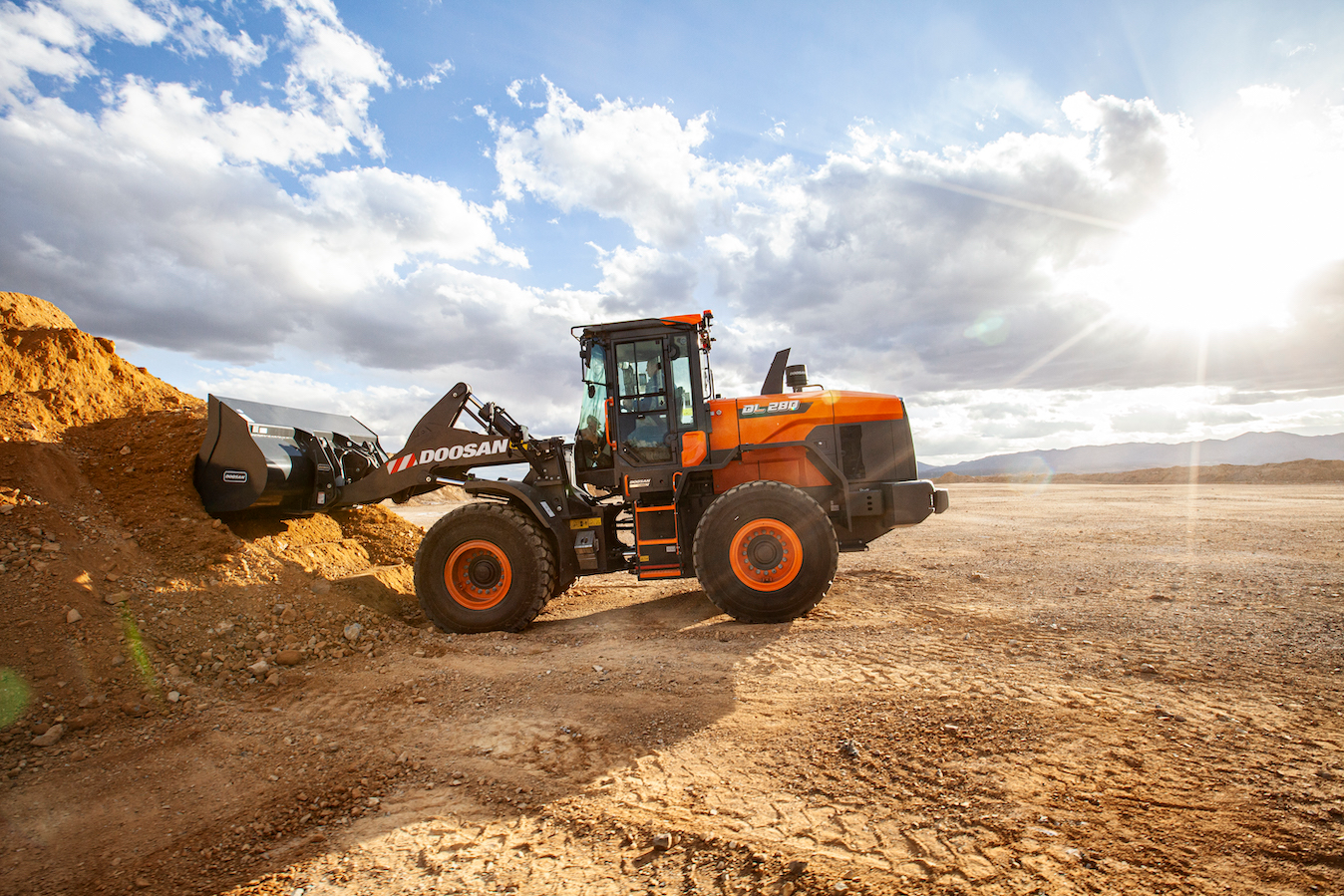
All Doosan -7 Series wheel loaders have the same cab layout with important and frequently used controls relocated for more intuitive access, a standard variable-speed, reversible fan that is adjustable from the Doosan Smart Touch screen, an optional automatic lubrication system and the Doosan Smart Guidance System that helps operators improve their efficiency.DoosanDoosan’s Situation Awareness Technology (SAT) 2.0 monitors multiple systems to provide optimal performance and fuel efficiency. The operator can tap a button or push the accelerator past a detent to move up one mode (Economy to Normal or Normal to Power).
Doosan’s Transparent Bucket uses one camera mounted low on the frame and a second mounted high on the cab. Software stitches together the two views to enhance visibility in front of the bucket. The system also has object detection.
Transparent Bucket can be retrofitted to existing machines with a kit that includes a monitor and an electronics module that interfaces with the loader’s CAN bus.
“Doosan is working toward our Concept-X integration and automation of the worksite,” says Aaron Kleingartner, dealer and product marketing manager, Doosan Infracore North America. “Our Transparent Bucket feature fits right in with that.”
Customer feedback drives Case updates
Case G Series loaders have updated features including a tablet-like touchscreen display, configurable buttons in the armrest, adjustable electrohydraulic controls and a fully integrated OEM payload system that improves load accuracy and provides detailed reporting.
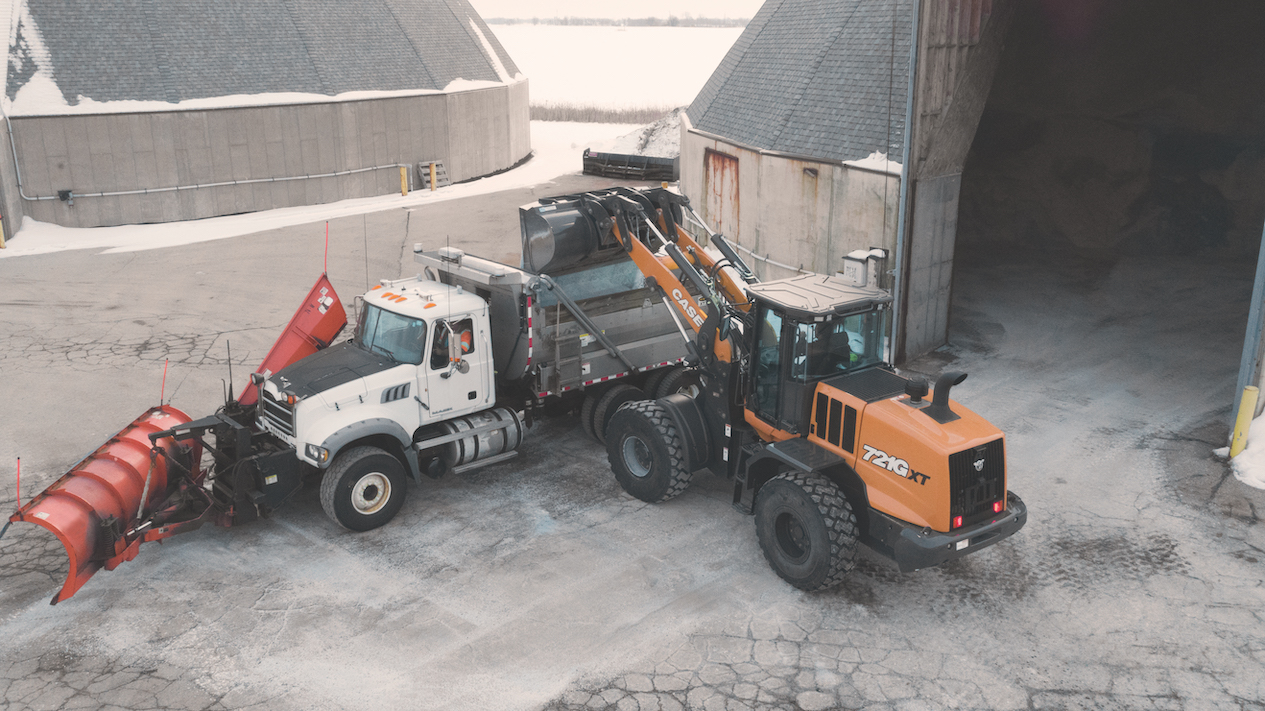
Case G Series loaders have a new touchscreen display that provides machine information and convenient access to operational controls, a new Smart Power Mode with enhanced communication between the engine and transmission to improve fuel efficiency and reduce wear, and enhanced telematics and integration with the Case North American Uptime Center.Case CEAlso new is the tire pressure monitoring system that shows pressures on the display and issues an alert for out-of-range readings. Power modes have been reduced to two: Smart and Max.
“These features came from feedback from customers and dealers,” says Andrew Dargatz, product manager, Case. “The result is increased productivity and uptime with decreased operational elements that hinder performance and profitability.”
Mecalac goes bigger
The AS1600 swing loader has been Mecalac’s only non-compact model. The company is now bringing its larger AS210 swing loader to North America.

The AS210 is Mecalac’s largest swing loader. Bucket capacity range is 2.7 to 3.9 cubic yards. Operating weight is 33,069 pounds. It is powered by a Deutz turbo diesel engine rated at 175 horsepower. Dump height is 134 inches. Turning radius is 16 feet 4 inches, thanks to four-wheel steering.MecalacThe appearance of the AS210 is unlike other Mecalac models, more angular and less flowing. “It was always intended to be a machine for heavier-duty applications, and it looks the part,” says Peter Bigwood, general manager, Mecalac North America.
As with other Mecalac swing loaders, the AS210 provides 90 degrees of loader swing left and right, has a non-articulated frame, and three-mode, four-wheel steering.
“The AS210 brings extra capacity to applications where the swing design is especially helpful such as backfilling and road jobs where it reduces the need for lane closures,” Bigwood says.
Deere’s three tiers
Deere is introducing its performance tiering strategy with wheel loaders. The G, P and X tier progress from basic, economical machines through machines with improved performance and comfort to machines with the latest features and technology Deere offers.

The 644 is the first John Deere wheel loader to be available in G, P and X tiers. The 644 X and P machines are now available for purchase in the U.S. and Canada; the 644 G machine is available in Canada and other global markets. Bucket capacities for the P and X tier machines are 4 to 4.75 cubic yards. (4.25 cubic yards G tier). Net power is 249 horsepower for the P and 231 for the X (227 horsepower for G tier).John DeereAs with its predecessors the 644K and 644L, the current 644 is an E-Drive hybrid with an engine-driven generator, an inverter, an electric motor and a PowerShift transmission specially optimized for use with the hybrid design. The 944K is also an E-Drive machine but uses four electric wheel motors.
Current Deere models 444 through 744 will be available in G, P and X tiers. “Those are recent models with no need for extensive modification to fit into Deere’s new tier structure,” says Luke Gribble, solutions marketing manager, Deere.
Komatsu’s transmission advancements
“Most wheel loaders are used as loaders and are designed to feed a process,” says Nathan Repp, product marketing manager of Komatsu’s WA200-8 through WA320-8. “However, all Komatsu loaders have optional auxiliary hydraulics for use with attachments and specialty buckets.”

The Komatsu WA475-10 has 22% more horsepower than the WA470-8 yet achieves up to 30% better fuel efficiency, thanks to the Komatsu Hydraulic Mechanical Transmission. KHMT also offers dynamic braking to reduce brake wear. Boom lift force is increased by 20% and breakout force by 8%. The new bucket design improves pile penetration and material retention.KomatsuAdam Brown, product marketing manager for Komatsu models WA320-8 through WA500-8, says the WA475-10 is the first of a new design and features the Komatsu Hydraulic Mechanical Transmission. The KHMT is a planetary gear design and provides stepless shifting. A dial sets a maximum travel speed while allowing full stroke of the accelerator for more precise control.
Other improvements include better ergonomics for the controls and switches, more glass area in the cab, and placement of the mirrors and rearview camera monitor at eye level.
Hyundai’s All-Around View

Hyundai HL900 series loaders have standard bucket capacities of 3 to 7.1 cubic yards. All models are available with standard or extended reach (XT) Z-bar linkage configuration. The HL940TM and HL955TM Tool Master models use a parallel linkage for greater lift capacity, improved load stability, rapid dumping capability and enhanced visibility.HyundaiHyundai Construction Equipment Americas’ A Series loaders feature enhanced onboard weighing that displays what’s in the bucket plus what’s in the truck. Names and target loads can be assigned to individual trucks.
An optional second monitor can be dedicated to the 360-degree, four-camera All-Around View Monitoring (AAVM) feature. The rearview system includes object detection. An optional radar further enhances safety.
Liebherr camera technology
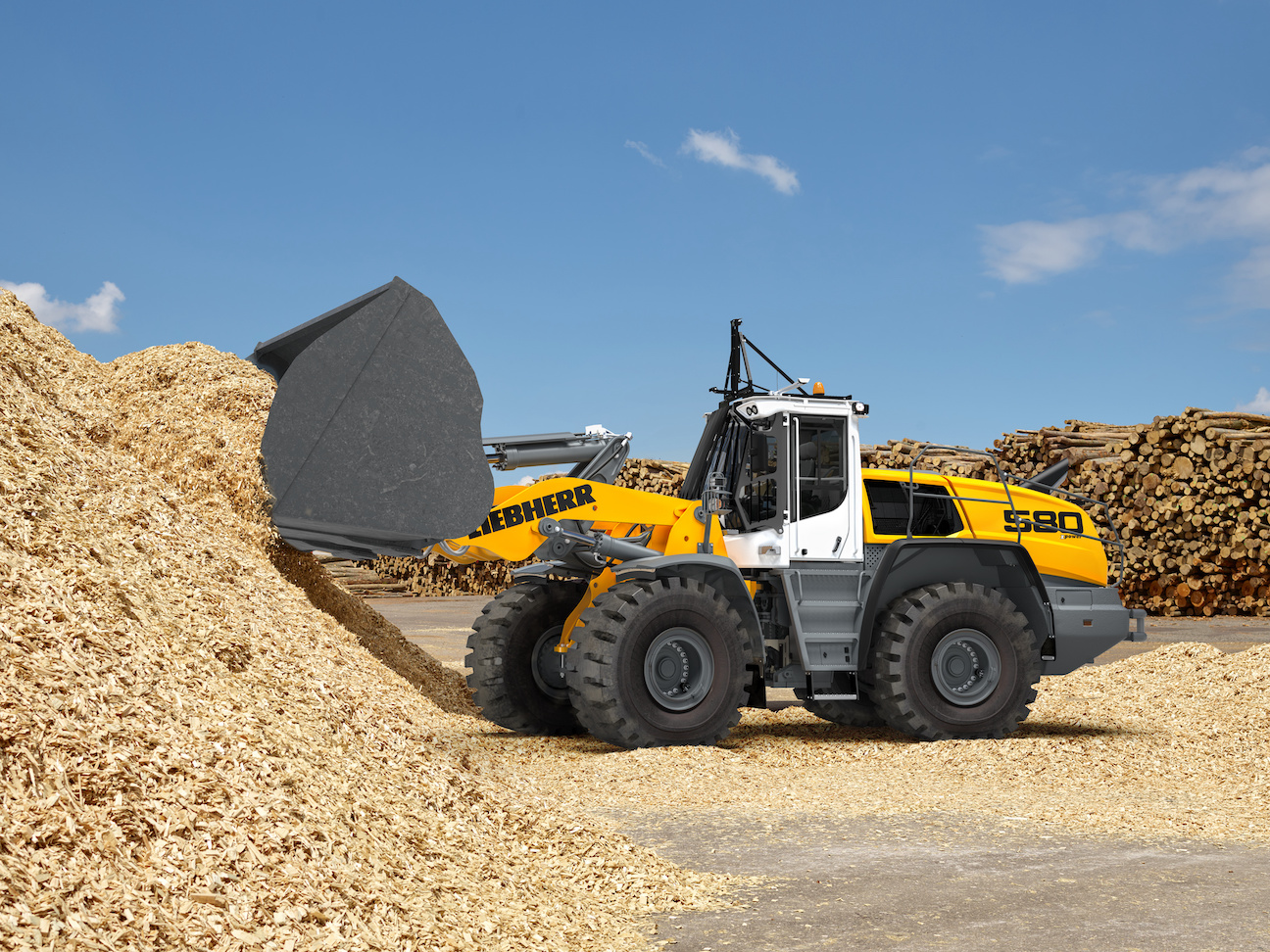
The L580 features Liebherr’s XPower continuous power split driveline. XPower is fully automatic and has no traction interruptions across the entire speed range (up to 24.9 mph forward and reverse). Power is from an inline 6-cylinder engine rated at 312 horsepower. Bucket capacity is 7.5 cubic yards, and operating weight is up to 63,490 pounds.LiebherrOptional Active Personnel Detection is now available on Liebherr wheel loaders to monitor the area behind the loader.
Brake assistant uses camera technology and distinguishes between people and inanimate objects. Warnings can be evaluated using LiDAT, Liebherr’s telematics system.
Optional joystick steering is available, and customers can opt for joystick steering only, with no steering wheel or column.
LiuGong’s gradual rollout
“Demand for new applications started coming in late 2018,” says Hugo Chang, wheel loader product manager, LiuGong North America.
All LiuGong wheel loaders have third-spool hydraulics. Smaller models are plumbed to the end of the loader arms because they use quick connects, which require hydraulics.

The LiuGong 848H is powered by a Cummins QSB6.7 engine rated at 175 horsepower and has a ZF powershift transmission. Operating weight is 35,260 pounds, and bucket capacity is 3.5 cubic yards. Switching attachments is easy with the quick coupler, and the Z-bar linkage yields high breakout forces and stable material transport with minimal spillage.LiuGongLarger machines, which use pin-on buckets, are plumbed to a midpoint on the arms. Pilot controls are used for lift and tilt while an electrohydraulic thumbwheel controls the third valve. The company’s two largest models, the 877H and 890H, are fully electrohydraulic.
Chang says new model introductions usually coincide with emerging emissions regulations. Their current Tier 4 Final models came to market in 2016 and are being replaced with European Stage V machines. Because there is no U.S. equivalent to Stage V – that is, no Tier 5 – there is no deadline for introduction and therefore no urgency to bring these models to market.
“This gradual rollout allows us to implement the change to best benefit LiuGong, our dealers and our customers,” says Chang. “All our North America wheel loaders will likely be Stage V machines by 2023.”
Volvo boom kickout, return-to-dig
Boom kickout and return-to-dig are key features on Volvo loaders. Boom kickout height is set by the operator and is operated with a single stroke of the lever.
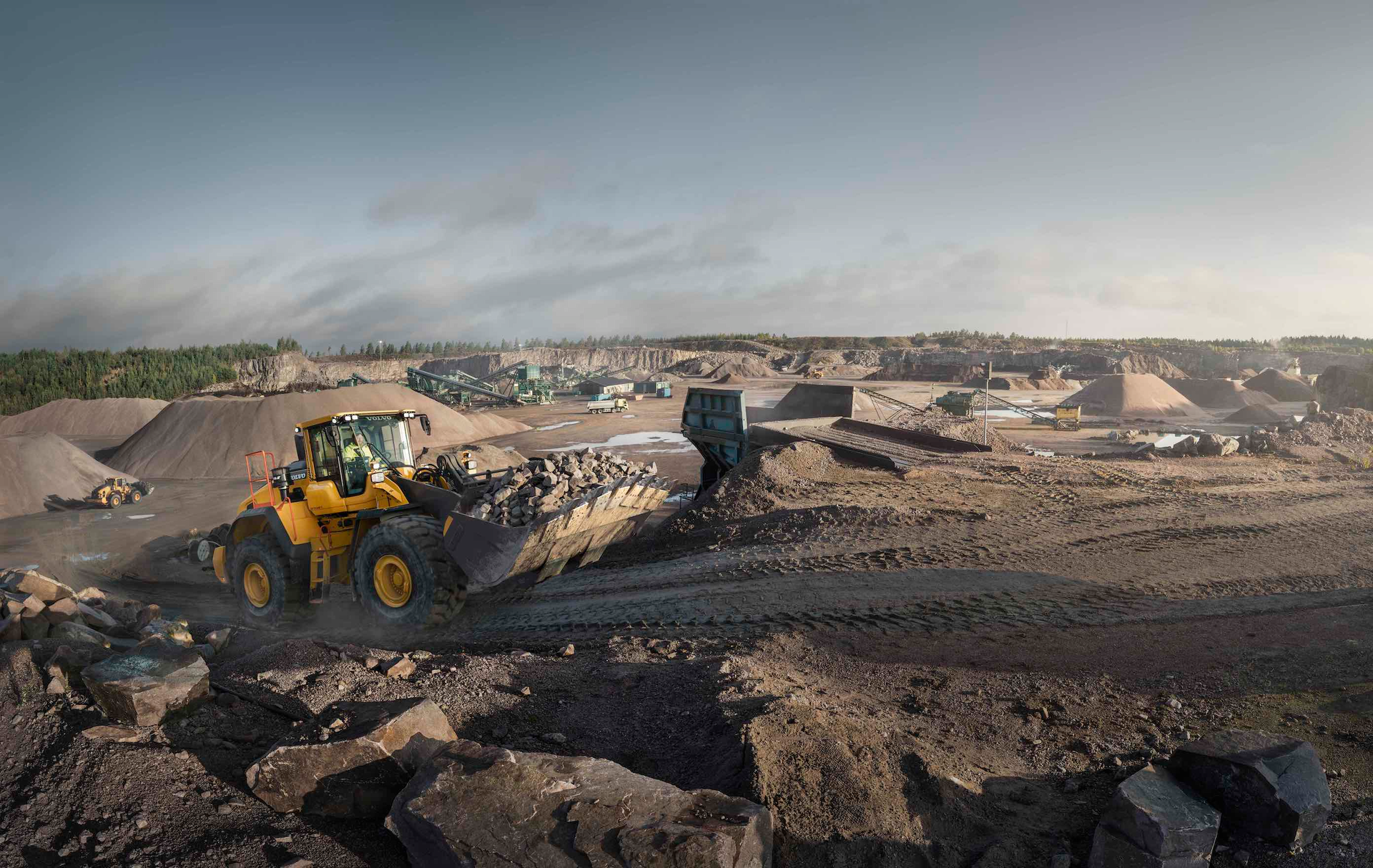
Volvo Construction Equipment is making its Load Assist machine control compatible with wheel loaders from the L60H to the L350H, including the L220H shown. Load Assist apps are operated via the Volvo Co-Pilot through the in-cab, 10-inch, high-resolution monitor. Calculator, Notes and Weather are called Toolbox Applications; tire pressure monitoring is also included. The Map app gives machine position and inter-machine telecommunication to provide real-time site activity.Volvo CE“It’s especially helpful when loading trucks at the same height for extended periods of time,” says Eric Yeomans, product manager for wheel loaders, Volvo CE North America.
Return-to-dig puts the bucket at the same position, again with a single lever stroke. Control sensitivity can be set to Soft, Normal or Active.
Lockup characteristics of Volvo models L110H through L260H can be set by the operator using OptiShift. The new lockup torque converter coupled with Volvo’s Reverse By Braking feature provides smoother directional changes, less driveline strain and greater fuel efficiency.
Wacker Neuson eases attachment switches

The largest Wacker Neuson articulated loader, the WL95, has a 2-cubic-yard bucket, 136-horsepower engine and Ecospeed PRO continuously variable hydrostatic transmission providing travel speeds of up to 24.8 mph. Flow to attachments can be easily adjusted using a jog dial. The articulation joint and pendulum rear axle provide a 96.5-inch inside turning radius with optimal traction.Wacker NeusonWacker Neuson puts a universal skid-style plate on smaller loaders, allowing attachments to be changed from the operator’s seat.
As the name suggests, this mounting plate is compatible with a range of attachments and work tools used with skid steer and compact track loaders.
Electrical and hydraulic connectors are standardized across Wacker Neuson models to further enhance compatibility.
Hitachi offers control options
Michael Winfield, product and applications manager, Hitachi Construction Machinery America (HCMA), says control configuration options vary by model. They can include three-spool control valve with multifunction and auxiliary levers; three-spool with two levers; four-spool with multifunction and auxiliary joystick; and four-spool with two levers and two auxiliary levers.
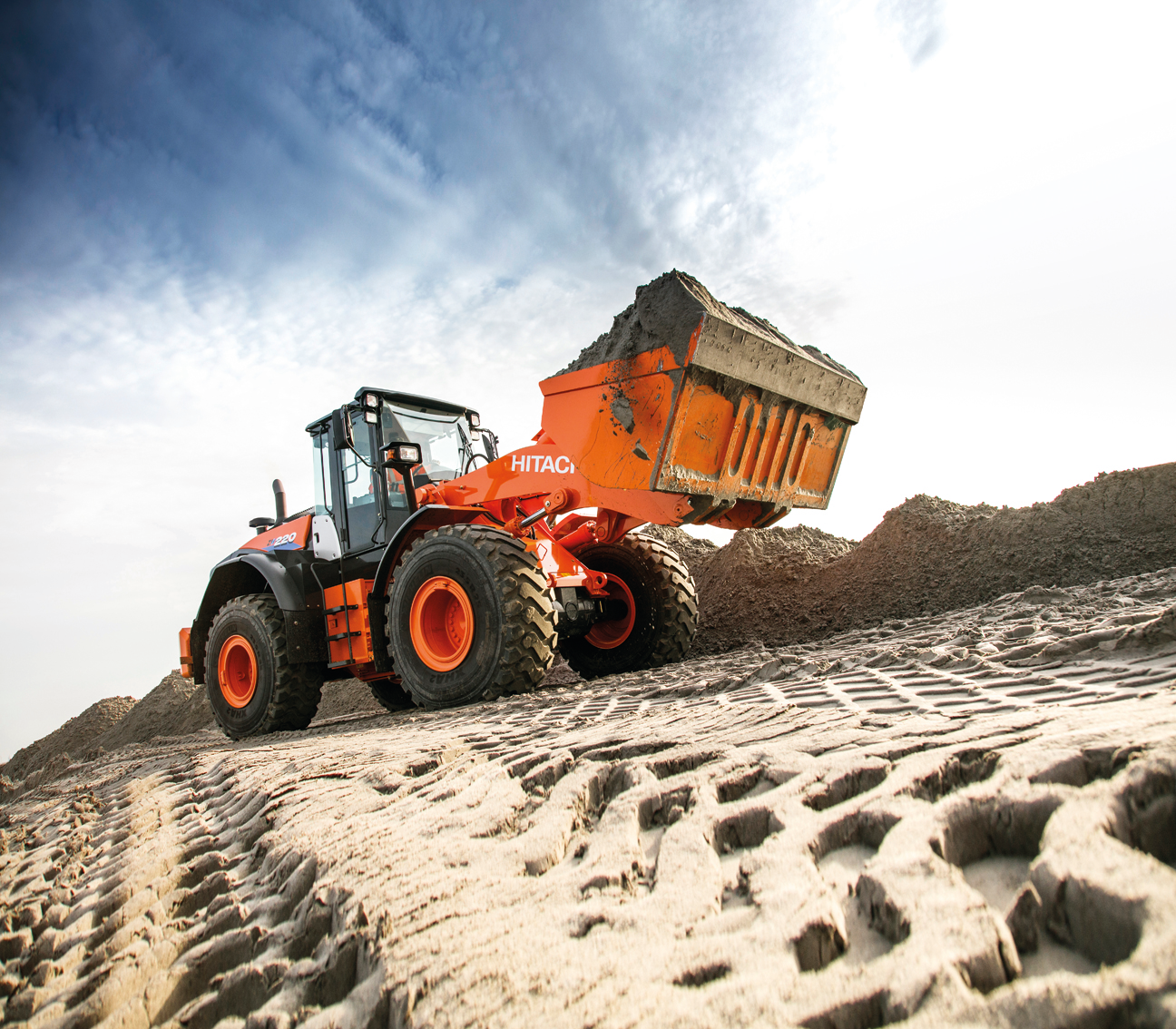
Key features on the Hitachi ZW220-6 include lift arm auto lever that allows the operator to set boom kickout via the multifunction screen, joystick steering, parallel/tandem hydraulics for more efficient lifting and dumping and a shift-to-hold switch that overrides automatic settings and allows the operator to hold the transmission in its current gear.HitachiApproach Speed Control automatically increases lift-arm speed while maintaining drive speed, and Intuitive Rim Pull Control provides additional power as required to boost breakout force in digging applications. Torque proportioned differentials minimize wheel slippage.
HCMA features also include ground-level-accessible grease points and an automatic reversible cooling fan and wide-fin cooling core.
Yanmar adds comfort

The V12 is Yanmar’s biggest wheel loader. Bucket capacity if from 1.57 to 2.35 cubic yards. Operating weight of this 100-horsepower loader is 15,432 pounds. A quick coupler is standard as is joystick control with third and fourth control circuit in one hand. Both axles have automatic-locking differentials. Hydrostatic drive provides infinitely variable speed control forward and reverse as well as an inching pedal.YanmarYanmar has one model in this size class, the V12. Its rubber-mounted cab includes HVAC, extra high-back suspension seating with lumbar support and two doors for easy access.
The joystick provides third- and fourth-spool controls. A central lubrication system is available.
Takeuchi focuses on owner-operators
Takeuchi also has one model in this range, the TW95. Features include a cab with air-ride suspension seating, two-speed travel and an inching pedal.
Top travel speed is nearly 25 mph; the inching pedal maintains engine speed while metering travel speed.
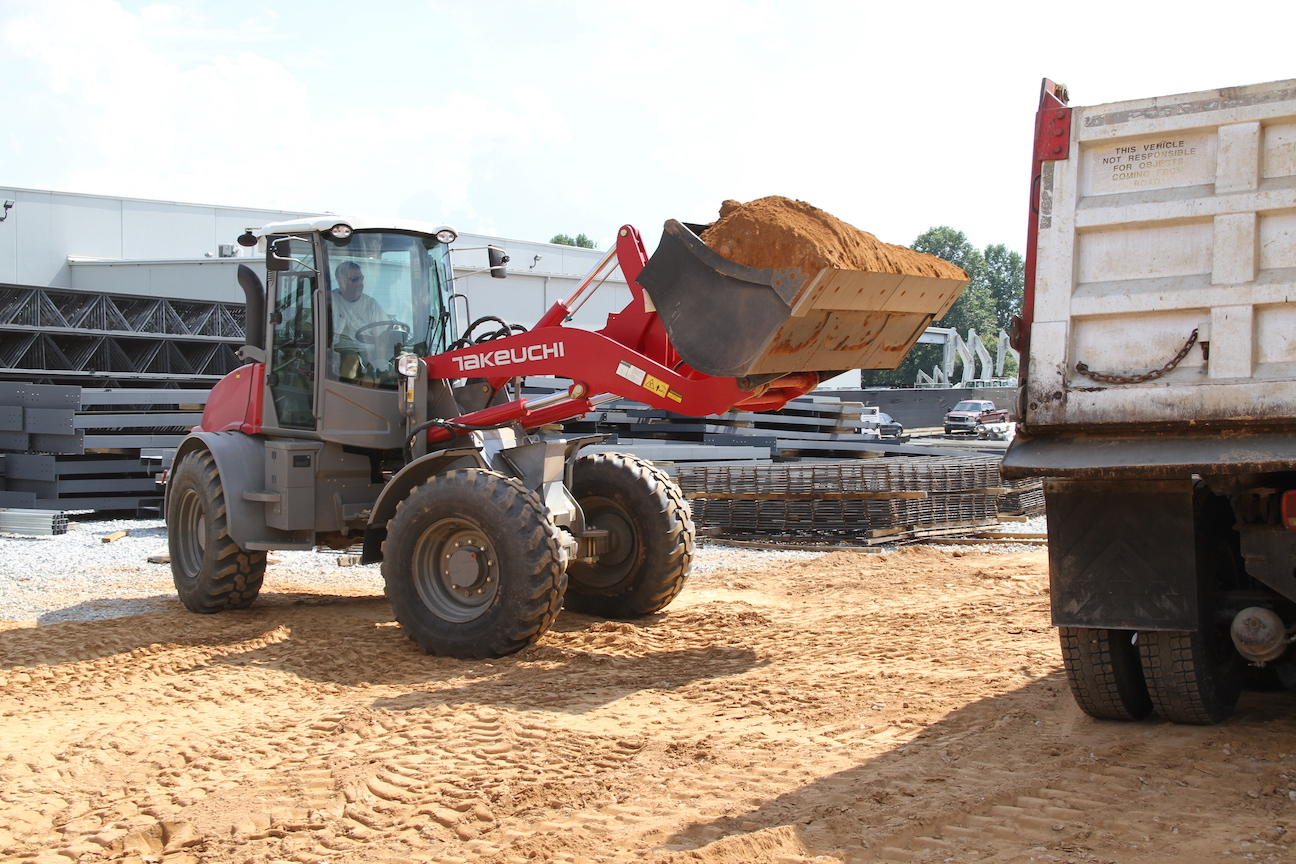
The Takeuchi TW95 is powered by a Deutz TCD 3.6 liter inline 4-cylinder engine rated at 114 horsepower. Differentials are 100% locking; 12 degrees of center pin oscillation allows equipment movement while keeping the operator’s station stable. Hydrostatic drive provides up to 24.8 mph travel speed and dynamic braking, slowing the loader as the operator backs off the throttle. Linkage is Z-bar for greater breakout and loader arm forces.TakeuchiStandard automation features include boom height kickout, return-to-dig and automatic bucket positioning.
“We make all our wheel loaders comfortable and easy to operate since many are purchased by owner-operators,” says Lee Padgett, product manager.
Did you miss our previous article…
https://constructionosa.org/?p=237
Best Recruitment Strategies For Construction Companies
Therefore, we have come up with this guide of the best recruitment strategies for construction companies. Construction recruitment process.
The post Best Recruitment Strategies For Construction Companies appeared first on ConstructionPlacements.
Did you miss our previous article…
https://constructionosa.org/?p=208